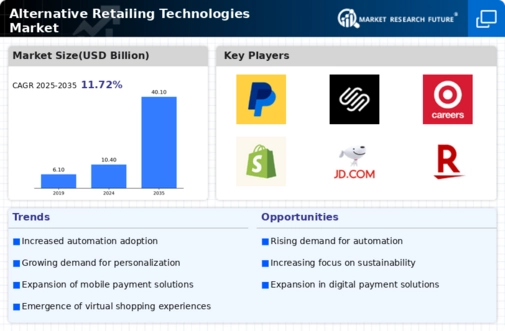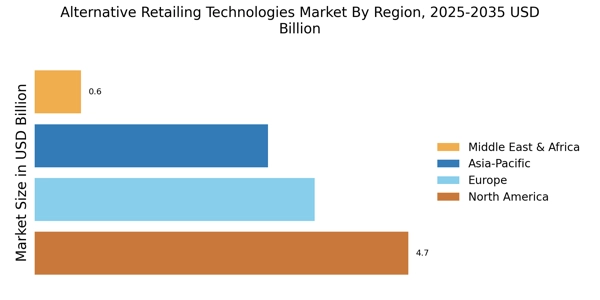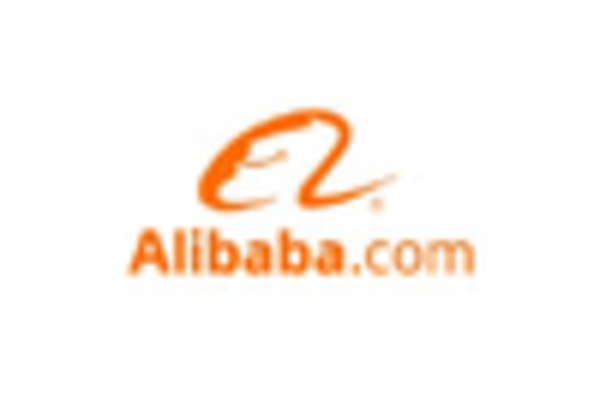Expansion of Mobile Commerce
The proliferation of smartphones is driving the expansion of mobile commerce within the Alternative Retailing Technologies Market. As mobile devices become ubiquitous, consumers are increasingly utilizing them for shopping, leading to a significant rise in mobile transactions. Recent statistics reveal that mobile commerce accounts for over 50% of total e-commerce sales, highlighting its importance in the retail landscape. Retailers are responding by optimizing their platforms for mobile use, ensuring that the shopping experience is user-friendly and efficient. This trend is likely to continue, as advancements in mobile payment technologies and app functionalities enhance consumer convenience. Consequently, the Alternative Retailing Technologies Market is expected to grow as businesses invest in mobile solutions to capture the attention of a tech-savvy audience that prefers shopping on-the-go.
Rise of Omnichannel Retailing
The shift towards omnichannel retailing is significantly influencing the Alternative Retailing Technologies Market. Retailers are increasingly adopting a multi-channel approach, integrating online and offline experiences to provide a cohesive shopping journey. Data suggests that companies employing omnichannel strategies can achieve a 10% increase in customer retention rates. This trend is driven by consumer expectations for flexibility and accessibility, prompting retailers to invest in technologies that facilitate seamless transitions between channels. As a result, the Alternative Retailing Technologies Market is evolving to support these integrated experiences, with innovations such as click-and-collect services and mobile apps that enhance customer engagement. The emphasis on omnichannel strategies is likely to shape the future of retail, as businesses seek to create a unified brand presence across various platforms.
Growing Focus on Sustainability
Sustainability is becoming a central theme within the Alternative Retailing Technologies Market. Consumers are increasingly aware of environmental issues and are favoring brands that demonstrate a commitment to sustainable practices. This shift is prompting retailers to adopt technologies that reduce waste and enhance energy efficiency. For instance, the implementation of smart inventory systems can minimize overstock and reduce carbon footprints. Recent surveys indicate that approximately 60% of consumers are willing to pay more for products from environmentally responsible companies. As sustainability becomes a key differentiator, the Alternative Retailing Technologies Market is likely to see a rise in innovations aimed at promoting eco-friendly practices. Retailers that prioritize sustainability may not only enhance their brand image but also attract a growing segment of environmentally conscious consumers.
Increased Demand for Convenience
The Alternative Retailing Technologies Market is experiencing a notable surge in demand for convenience-driven solutions. Consumers increasingly favor shopping experiences that minimize time and effort, leading to the adoption of technologies such as mobile payment systems and automated checkout solutions. According to recent data, nearly 70% of consumers express a preference for retailers that offer seamless, quick transactions. This trend is likely to drive innovation within the industry, as businesses strive to enhance customer satisfaction and loyalty. Retailers are investing in technologies that streamline operations, thereby improving efficiency and reducing wait times. As a result, the Alternative Retailing Technologies Market is poised for growth, with companies exploring new avenues to meet the evolving expectations of consumers who prioritize convenience in their shopping experiences.
Advancements in Artificial Intelligence
Artificial Intelligence (AI) is playing a pivotal role in transforming the Alternative Retailing Technologies Market. The integration of AI-driven solutions enables retailers to analyze consumer behavior, optimize inventory management, and personalize marketing strategies. Recent studies indicate that AI can enhance customer engagement by up to 30%, as it allows for tailored recommendations and targeted promotions. Retailers are increasingly leveraging AI to predict trends and manage supply chains more effectively, which can lead to reduced operational costs. This technological evolution not only improves the shopping experience but also empowers retailers to make data-driven decisions. Consequently, the Alternative Retailing Technologies Market is likely to witness significant growth as businesses adopt AI to stay competitive and meet the demands of a tech-savvy consumer base.


















Leave a Comment